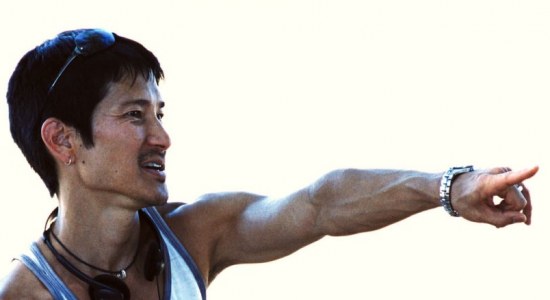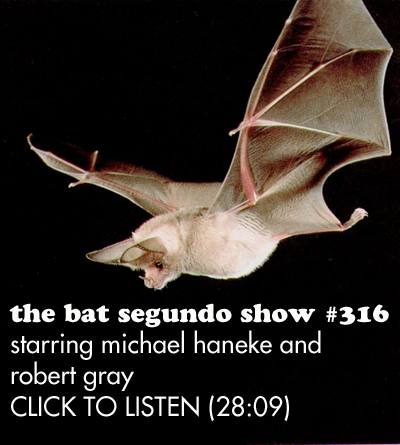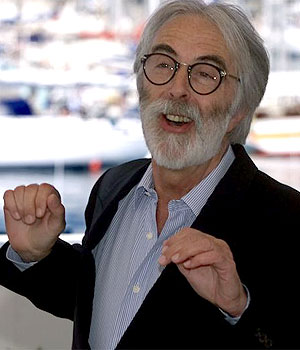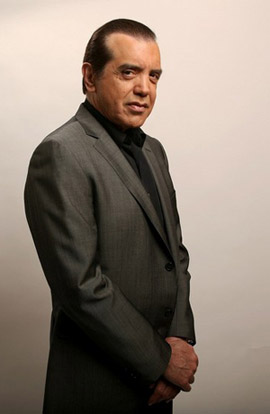Gregg Araki appeared on The Bat Segundo Show #377. Mr. Araki is most recently the writer and director of Kaboom, which opens today in theaters.
Listen: Play in new window | Download
Condition of Mr. Segundo: Staring at the canvas from a low angle.
Guest: Gregg Araki
Subjects Discussed: [List forthcoming]
EXCERPT FROM SHOW:
Correspondent: Gregg, how are you doing?
Araki: (with some irony) I am doing fantastic.
Correspondent: End of the day. Uh, no visuals. But anyway…
Araki: In other words, “you don’t look fantastic.”
Correspondent: You do look fantastic! You look like…
Araki: Can we say “shit” on this?
Correspondent: You can. You can say “shit.” We can talk Totally Fucked Up. Whatever you want.
Araki: Okay. Good. Yeah, I look like shit.
Correspondent: You have exacting standards. I wanted to talk about your aesthetic. I noticed that over the course of twenty years, the camera’s position has actually grown. It started off as being very much on the floor.
Araki: (laughs)
Correspondent: Very on the ground. You would see giant billboards. Chevron gas stations. And as we’ve seen you evolve as a filmmaker, we’ve seen the camera actually rise up from the ground.
Araki: Interesting.
Correspondent: And I’m curious about how this aesthetic built.
Araki: In this film [Kaboom], there’s that crazy crane shot.
Correspondent: Yeah.
Araki: Interesting. That’s an interesting metaphor for my filmmaking style. It’s gone from underground to above ground.
Correspondent: Yes, exactly. Well, actually, roughly, the camera’s waist-high.
Araki: Yeah, I used to use a lot of what’s called a hi-hat. It’s just a plank of wood with a tripod head. And I was concentrating on the hi-hat a lot.
Correspondent: Was this more your way to look distinct? Because you had pretty much nothing but a hi-hat?
Araki: I think it was also just aesthetically appealing to me. And I think it’s partly — you know, my movies are about these characters who are in this vast, hostile universe. And I think that you get that — particularly with a wide angle, a wide low shot, you get a sense of this universe being this vast and dangerous place. I think that sense of space comes a lot from that angle. You get a sense of that openness.
Correspondent: Well, I’m curious about space. I was mentioning the Chevron gas station. And we see, for example, the Vermeer in Mysterious Skin. In this movie, at the cafe, there’s the big space in the back where we see WELCOME TO THE ONTOLOGICAL VOID. I’m curious as to how this also developed. This large widescreen environment for characters to often walk into and go ahead and bitch and moan.
Araki: You brought up many interesting things that will be in dissertations done on my movies after I’m dead, I’m guess.
Correspondent: Ah.
Araki: Because a lot of my movies — particularly the early, early ones, the black-and-white, the two ones that were before The Doom Generation — is frequently characters walking at night against these phantasmagorical backdrops of Los Angeles landscape. Usually talking about the meaningless of existence. And it’s something that’s been in a lot of my movies. There is still that sense, even in Kaboom. There’s a shot in particular that’s very, very similar to one of those shots. Because I remember we were on the hi-hat. The shot where Smith is being chased by the animal men, and he runs into that crazy weird stairwell that’s almost something out of a nightmare. That shot is very reminiscent of those shots. Because it’s also so much about the location and its natural light. It’s this weird lit-up stairwell, but the DP did light it. Most of the stuff is actually from the structure itself.
The Bat Segundo Show #377: Gregg Araki (Download MP3)


 Correspondent: In Funny Games, you have a scenario in which we don’t actually understand the motivations of the two killers. Cache, same thing. The actual motivation behind the videotapes is not entirely spelled out. And, of course, in The White Ribbon, we have a similar situation in which its more about the consequences than it is about the origins. And I’m curious why your films tend to not dwell upon the origins of terrible acts, as opposed to the consequences. Do you think that looking for the root cause of human behavior is a folly? At least with these particular characters in your film?
Correspondent: In Funny Games, you have a scenario in which we don’t actually understand the motivations of the two killers. Cache, same thing. The actual motivation behind the videotapes is not entirely spelled out. And, of course, in The White Ribbon, we have a similar situation in which its more about the consequences than it is about the origins. And I’m curious why your films tend to not dwell upon the origins of terrible acts, as opposed to the consequences. Do you think that looking for the root cause of human behavior is a folly? At least with these particular characters in your film?
 Correspondent: Going back to the issue of preparation, perhaps you can talk about it in light of this particular movie. I’m curious if there is such a thing as overpreparation for you. For a performance like this, for a performance elsewhere. Where if you plan something too much, then you’re going to lose the spontaneity, you’re going to lose the naturalness of human behavior, and the like.
Correspondent: Going back to the issue of preparation, perhaps you can talk about it in light of this particular movie. I’m curious if there is such a thing as overpreparation for you. For a performance like this, for a performance elsewhere. Where if you plan something too much, then you’re going to lose the spontaneity, you’re going to lose the naturalness of human behavior, and the like.